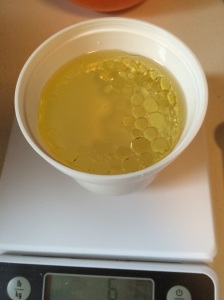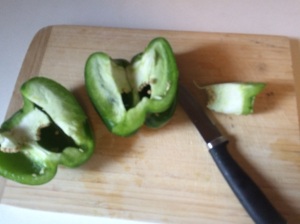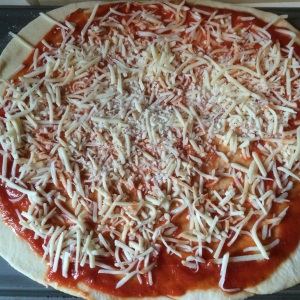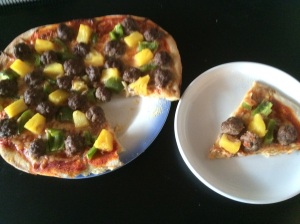Source: Coraline, by Neil Gaiman, a book a kid in the last few days of summer vacation, who’s not too excited about her family’s new apartment in a big old house, quirky neighbors who seem to keep telling the same stories, and parents who can’t seem to pay attention to her—
Coraline’s father stopped working and made them all dinner.
Coraline was disgusted. ‘Daddy,’ she said, ‘you’ve made a recipe again.’
“It’s leek and potato stew, with a tarragon garnish and melted Gruyere cheese,” he admitted.
Coraline sighed. Then she went to the freezer and got out some microwave chips and a microwave mini pizza.
“You know I don’t like recipes,” She told her father […].
“If you tried it, maybe you’d like it,” said Coraline’s father, but she shook her head. (18-19)
–and discovering an alternate home, family, neighbors, and life through a previously bricked-up door.
“Yes,” said the other mother. “It wasn’t the same here without you. But we knew you’d arrive one day, and then we could be a proper family. Would you like some more chicken?”
It was the best chicken that Coraline had ever eaten. Her mother sometimes made chicken, but it was always out of packets, or frozen, and was very dry, and it never tasted of anything. When Coraline’s father cooked chicken, he cooked real chicken, but he did stranges things ot it, like stewing it in wine, or stuffing it with prunes, or baking it in pastry, and Coraline would always refuse to touch it on principle.
She took some more chicken. (40)
While everything in this new world, which isn’t very big, is designed to let Coraline have fun, feel adored, and eat the food she likes, there’s something off about it from the beginning. When she goes back to her real apartment to find her “old”, flawed, real parents are gone, Coraline must fight through an increasingly twisted “new” world to get back the life she’s just begun to appreciate.
Context: Coraline is a good analysis waiting to happen. I haven’t touched the meaning of apples or hot chocolate in this book. But the pizza from the end seemed best for the blog.
Also, since it’s founding, I’ve hardly been a devout observer of Pizza Week, and this was a way to atone.
Just before her final battle, Coraline is reunited with her parents, back in their real house.
Dinner that night was pizza, and even though it was homemade by her father (so the crust was alternately thick and doughy and raw, or too thin and burnt), and even though he had put slices of green pepper on it, along with little meatballs and of all things, pineapple chunks, Coraline ate the entire slice she had been given.
Well, she ate everything except the pineapple chunks. (162)
There’s a lot going here. First, Coraline’s showing some maturity and appreciation by eating her father’s pizza instead of beelining for the freezer again. She’s grown.
Second, the pizza itself is important. Its bad base and weird combination of toppings are physical proof that Coraline’s real father is truly back. If he, Mr. Jones, had produced a perfectly baked, plain cheese pizza, that would be suspect.
But as it is, it shows that he’s here, in the flesh, still flawed and unchanged. Probably a little frazzled from his time away, and probably scrounging ingredients from the freezer and cabinets, but definitely himself. When she eats the pizza, Coraline knows for sure.
It’s kind of a spin on Jesus eating the fish on the beach.
Recipe: Coraline was published in 2002. It doesn’t specify a setting, but it’s pretty clearly Britain (and thank goodness it never pretends to be anywhere else.) Both Mr. and Mrs. Jones work from home, on computers.
I’m sure they both still take breaks on the late 90s/early 2000 BBC site, but from what I can tell it’s a little too early yet for BBC Food to be online.
Still, it seems reasonable that Mr. Jones gets his “recipes” from magazines and TV aimed at the same audience as the BBC Food site. With that big assumption (for my convenience), I used this basic pizza recipe:
http://www.bbc.co.uk/food/recipes/how_to_make_pizza_50967
I’m linking it rather than copying it, because if you’re actually making pizza you’ll be better off following those steps than mine.
Such as it is, the following is for entertainment purposes only.
After all, flawed pizza is the whole point.
Ingredients: Flawed pizza and scrounged cupboards being the point, I replaced the semolina with cornmeal. I’m in America and semolina is pricey and requires a special trip to the store that’s farther away.
I don’t recommend the substitute.
You could argue for using frozen meatballs here, but where’s the fun.
Equipment: Mr. Jones probably has a pizza stone he’s used once or twice or never, hence the crust that’s alternately raw and burnt.
I used an upside down baking tray, which was just as likely to get the same results.
Process:
Mixing the dough is pretty straightforward.
Rather than have two lumps of dough that wouldn’t work, I halved the recipe.
I left the dough to rise, with not much hope that it would.
I was concerned the yeast wouldn’t work, because it had nothing to eat.
Normally, in breadmaking, you’d mix yeast with a little warm water and sugar. The yeast particles “eat” the sugar, process it, and pass gas, which is where the bubbles and rising action comes from. I questioned how dry yeast mixed straight with these ingredients would activate.
Also, my kitchen was freezing. Eventually I had to turn the oven on and open it.
Still, this was the dough after an hour and a half:
I punched the air out anyway, ’cause it’s fun. Press down with the heel of your hand. You get a feel for handling dough after a while.
Here’s where my summers working at a bakery/pizzeria really started to come back.
Note that while I handled and rolled bulbs of pizza dough, assembled pizzas, and prepped toppings (until they thankfully outsourced those job to the pizza pros and put me on the counter full time) I never made the dough itself.
While this dough “rose” more, I prepped these toppings.
I thought Mr. Jones might have had the notion to imitate homemade sausage meat. So I seasoned the ground beef with basic Italian seasonings: oregano, basil, parsley, garlic powder. Some thyme would’ve gone down well, too. I added a little egg white (what was in the fridge, again) to bind it together.
Then, rather than get raw meat all up in my phone, I took a picture of the “after” meatballs.
It’s not a huge challenge to cut a green pepper semi-nicely. Here’s where my summers working at a bakery/pizzeria started to come back:
Those slices/dices would not have passed pizza place muster.
Then, I started with basic tomato sauce out of a can:
And added the same seasonings as in the meat, plus a little ground red pepper.
If I weren’t making *this* pizza from *this* scene of *this* book, I’d go for some onion powder, black pepper, and honey in here, too, which is all I remember of our store’s incredibly addictive sauce recipe.
When this was all done, I gave up on the dough rising:
Surprisingly, it rolled out and held its shape.

Roll back and forth with your rolling pin for a few strokes, then give the dough a quarter turn and roll again for an even stretch. Keep going until you have a rough circle.

If you like, pick up the dough, drape it over your fists, and use your knuckles to rotate and gently stretch the center.
I shook cornmeal over the baking tray and placed the dough, now a base, on it.
About 2-3 tbs. of sauce will be enough. This is a little more than we would’ve been trained to put on saleable pizzas, but what amateurs like me and Mr. Jones tend to like:
Cheese should leave some red showing through:
Toppings go in a radial pattern:
Drained and rinsed pineapple:

As we’ll see, I should have dried it, too, and cut the chunks smaller or bought a can of “pieces” instead of “chunks”. But it’s “chunks” that Coraline leaves on the plate.
Raw meat goes on last, so you can wash your hands efficiently when it’s all done.
I was scared to put this in my oven on the highest heat, so I put my oven at 425. When the pizza still looked pale after 10-15 minutes (longer than the recipe gives), I turned it up to 450.
This is too wet.

Smaller pineapple chunks definitely needed! Also, maybe brown the meatballs briefly in a pan first to get some of the excess fat out.
But it looks less wet here.
I ate a slice (leaving the pineapple on), and it was okay.
I ate another sliver and then realized just how raw this was. Like, actual dough still in the center raw.
I put it back in the oven for a while. Sadly for authenticity’s sake, it baked more, but I still couldn’t achieve burnt patches. Though the weird, heavy texture produced by the cornmeal makes up for that in my opinion.
The meatballs were a little bland, too, but overall it actually wasn’t half bad. Especially cold, when the crust’s issues were less noticeable, the pineapple/meatball combination worked well and the peppers are pretty inoffensive.
A good thing, too, since this was a real investment in time, food, and effort and I had to eat it for 3.5 meals.
Still, if I was a picky eater my dad was a gourmet hobbyist who didn’t quite have his techniques down, I’d have total faith this came from the real him.
Next time: something Lenten. Suggestions welcome.
The Wednesday Woman/Coconut Lady

































Yay, Pizza Week!!
LikeLike
Two comments: First, my favorite part of no longer working in food service is that in the real world, cut sizes don’t matter (as with your green pepper). Second, pineapple on pizza is my favorite thing ever and this looks delicious.
LikeLike
I am laughing SO much at “Daddy, you’ve made a recipe again ….” Those words must often go round in the head of my 14-year-old, who isn’t quite as hard to feed as when she was six, but who missed the gene for culinary adventure (indeed, for adventure in general). Fortunately, my “recipes” don’t feature half-raw pizza crusts and pineapple chunks, but they can encompass toad-in-the-hole with roasted red onion or chicken-and-sausage jambalaya.
LikeLike
Mmm…do you have a food blog by any chance?
LikeLike
I have a blog, and many of the most recent posts have recipes in them, but I wouldn’t call it a food blog, only a “whatever I feel like posting, which is often a recipe” blog. (The food posts do have their own category, so you can find them without tons of searching.)
http://www.curmudgn.net/minutiae/
LikeLiked by 1 person